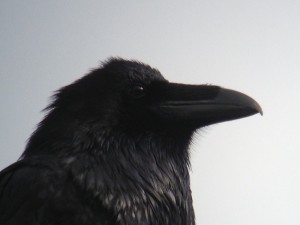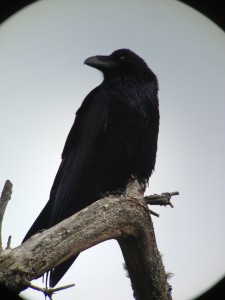Archive for January 2014
 In October 2011, in late afternoon on a clear fall day, a large congregation of Common Ravens was observed along Route 30 in the central Adirondack Town of Long Lake, New York near the intersection with Sabattis Circle Road. Well over one hundred ravens perched up in trees lining the highway in an area that contains both boreal and mixed forest habitats. The ravens were extremely vocal, loudly giving their seemingly endless array of calls. From the vantage point of my car-blind parked at the intersection, and with windows down, observations continued for over two hours.
In October 2011, in late afternoon on a clear fall day, a large congregation of Common Ravens was observed along Route 30 in the central Adirondack Town of Long Lake, New York near the intersection with Sabattis Circle Road. Well over one hundred ravens perched up in trees lining the highway in an area that contains both boreal and mixed forest habitats. The ravens were extremely vocal, loudly giving their seemingly endless array of calls. From the vantage point of my car-blind parked at the intersection, and with windows down, observations continued for over two hours.
The Common Ravens deafening chorus of calls continued. After about ten minutes, Eastern Coyotes began to howl from a long distance away in the forest across the highway from my vehicle. Two ravens, loudly vocalizing, flew in the direction of the coyotes. They flew back and forth between the large gathering of ravens and the direction of the howling coyotes. The howling ceased and the ravens continued to loudly vocalize with the pair of ravens continuing their flights toward the coyotes and then back again toward the other ravens. About a half hour later, crunching leaves were heard as unseen animals paced back and forth just behind the trees up on the bank along the highway directly across from my vehicle. The ravens continued to vocalize. As it began to grow dark, a coyote appeared at the top of the bank and headed down to a fresh road-killed deer in the ditch. All of the ravens instantly ceased vocalizing in perfect unison. They stared down at the coyote heading for the deer and remained perfectly still. The coyote began to rip at the deer with its mouth. After a while, a second, much lighter-colored coyote appeared at the top of the bank and tentatively headed for the deer. It was fearful of the passing vehicles, and would run back into the forest every time one passed by. The other coyote appeared unafraid of the traffic. But during a long lull in passing vehicles, it became apparent that the lighter-colored coyote was dominant and a vicious fight ensued with the darker-colored coyote quickly backing off. Each time a vehicle passed, the lighter-colored coyote would run into the forest and the darker-colored coyote would try to feed while the dominant coyote was gone. The darker coyote would immediately back away from the deer carcass when the lighter coyote came back down the bank. The ravens continued to remain absolutely silent and still on their perches as they stared down at the deer carcass and coyotes. They did not attempt to fly down to the carcass as the coyotes began to rip it open.
As it grew quite dark, groups of ravens began to head to a roost somewhere south of the highway. Just as it appeared they had all flown away, two ravens made a circle over the deer carcass in almost total darkness before flying off. It had now grown too dark to observe the coyotes at the deer carcass, so observations ended when the last two ravens flew to their roost.
 Interpreting animal behavior and communication can often be challenging. Common Ravens need scavengers, like coyotes, to rip open the skin of large mammals before they can feed. If a raven can alert a coyote to potential live prey or carrion, both species benefit. Common Ravens feeding on other predators’ kills is well documented, but ravens leading predators, such as coyotes, wolves, bears, or cougars, to potential live prey or carrion, by using vocalizations, is not as well documented.
Interpreting animal behavior and communication can often be challenging. Common Ravens need scavengers, like coyotes, to rip open the skin of large mammals before they can feed. If a raven can alert a coyote to potential live prey or carrion, both species benefit. Common Ravens feeding on other predators’ kills is well documented, but ravens leading predators, such as coyotes, wolves, bears, or cougars, to potential live prey or carrion, by using vocalizations, is not as well documented.
Bernd Heinrich offers possible evidence in his book Mind of the Raven, which suggests ravens lead predators to potential food. In a couple of the news stories he recounts, humans credited ravens’ vocalizations with saving their lives – one from a cougar and one from a bear. Heinrich has just the opposite interpretation and believes that the ravens were alerting these predators to potential prey, and as a result, both species would benefit with food. It is a much more likely explanation than ravens benevolently vocalizing to save a human from a potential predator!
The October 2011 observations appeared to be Common Ravens leading Eastern Coyotes to carrion through vocalizations. It is a mutually beneficial relationship when predators pay attention to raven (or crow) vocalizations that lead to potential food for both species. Ravens cannot kill large prey nor open the skin of large carrion (such as intact road-killed deer). But they can easily spot potential live prey and carrion from the air. By ravens utilizing vocalizations to communicate, and lead, land-based predators to live prey or carrion that the ravens have observed from above, benefits both species with food. This apparent symbiotic relationship between Common Ravens (along with other corvids such as American Crows) and predators merits further study.
A Couple of Other Brief Related Observations
Over a decade ago, loud American Crow vocalizations were heard outside our home in Long Lake, New York in the central Adirondack Mountains. From the vantage point of our front porch, two American Crows were observed. One was perched over an out-building, and another in a tree across the lawn. Between the crows, an Eastern Coyote was slowly making its way toward the crow over the out-building. At the time, a feral cat had taken up residence in this building. The coyote eventually spotted me and ran off. It appeared that the crows were luring the coyote toward the building with the feral cat. It is difficult to clearly interpret this type of behavior, but there appeared to be communication going on between the American Crows and the Eastern Coyote that morning.
During a decade hiking with two Golden Retrievers, it quickly became apparent that there is an innate relationship among corvids and canines. Common Ravens were encountered on nearly every hike and the ravens appeared to be attracted to the dogs, and the dogs nearly always responded to raven vocalizations by looking up. It was a relationship that could not be missed over the course of a decade!